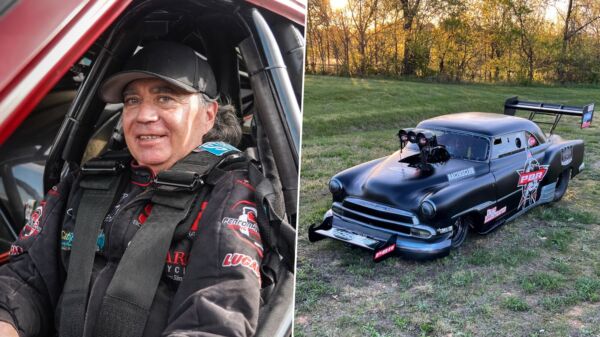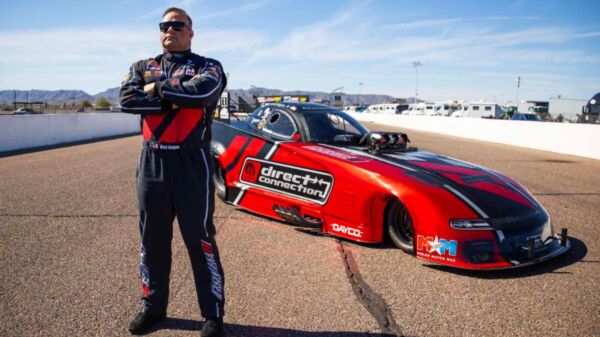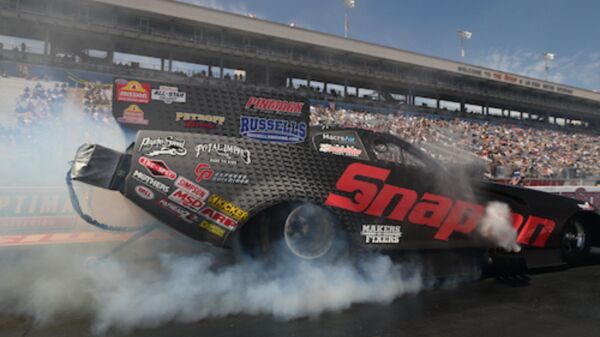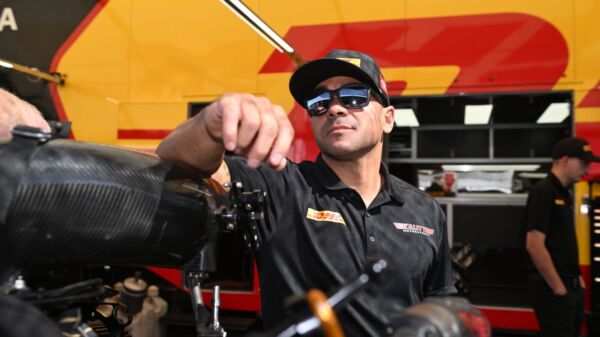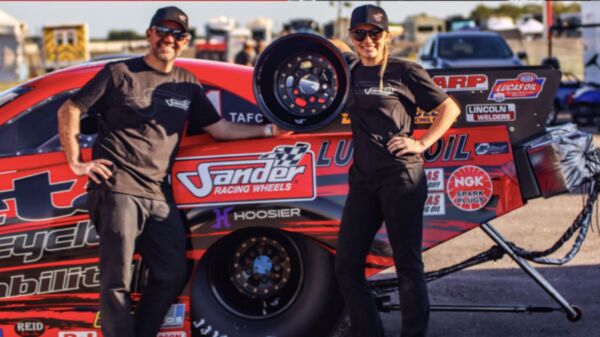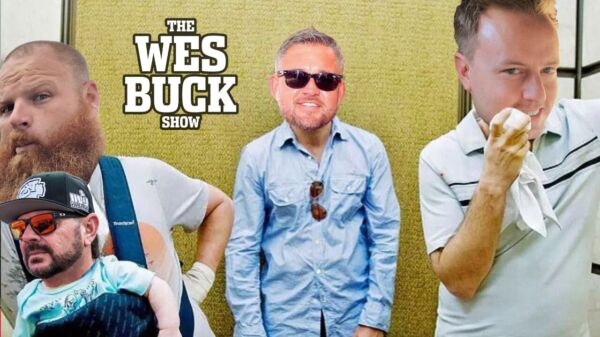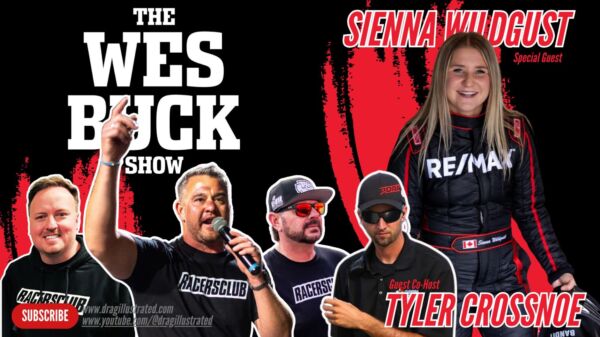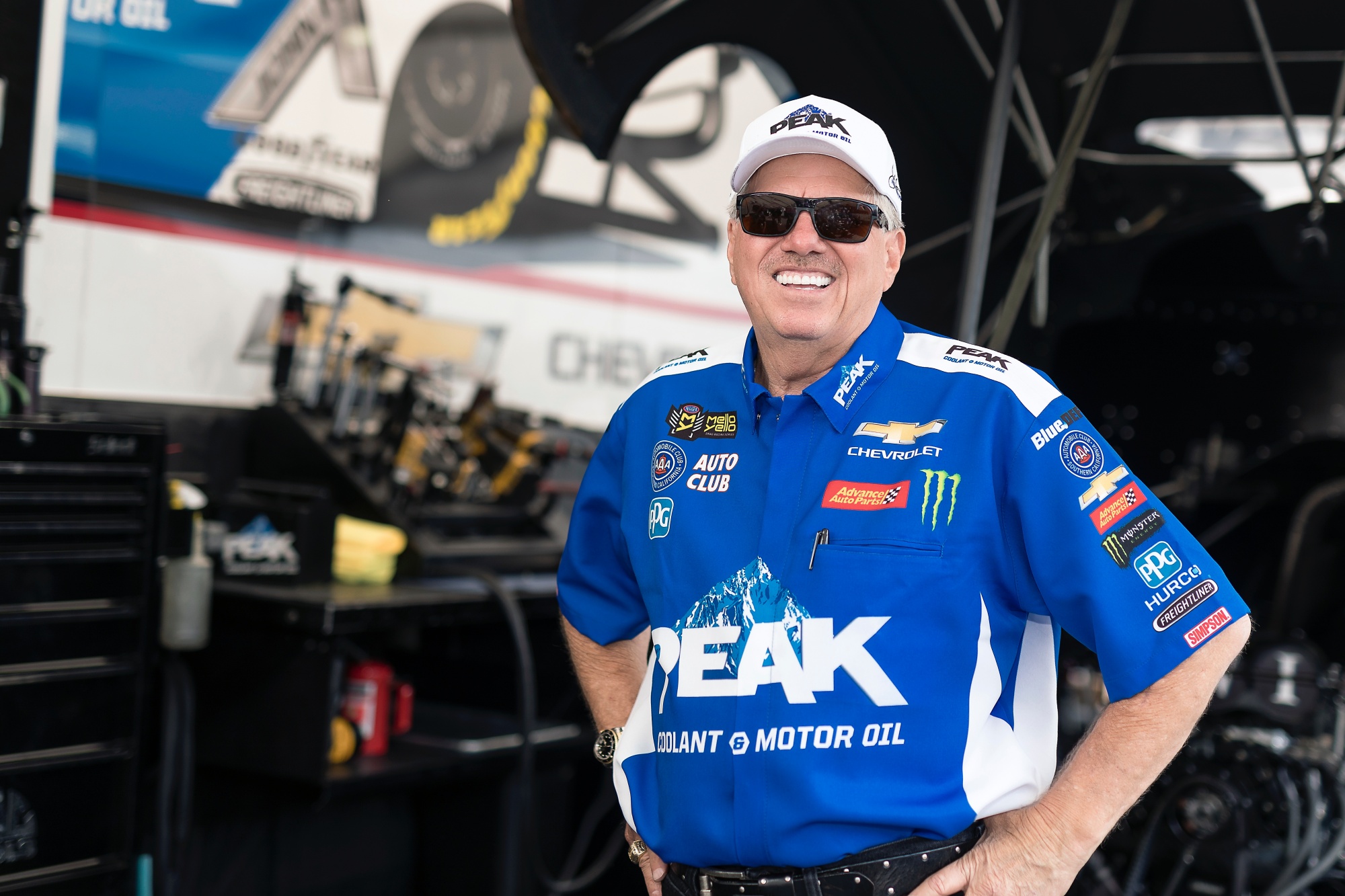It’s been a minute since my last sit-down interview with John Force – almost eight years – and it’s hard to overstate how much has changed since then. About 36 months removed from a harrowing crash at the Texas Motorplex outside Dallas that nearly took his life, our first interview for the cover of DRAG ILLUSTRATED was primarily a story of redemption and a dream realized for one of drag racing’s most beloved stars and living legends. Having recently sealed the deal on his 15th NHRA Funny Car world championship, which he had earned in dominating fashion with six wins in 11 final round appearances, the then 61-year-old Force was living his best life. Working out daily, swearing off alcohol, the California-born wheelman and self-made millionaire had rededicated himself to his family and looked to the future with bright eyes.
[Editor’s Note: This story originally appeared in DI #135, the State of Drag Issue, in July of 2018.]
Admittedly removed from the dominating days of 10-straight titles (yes, 10 in a row, with only Cruz and Tony Pedregon keeping him from 15 back-to-back championships) and likely operating in as competitive of an on-track environment as he’d ever known, Force, at the time, insisted he’d have only five years left behind the wheel of a race car. He believed his life would soon revolve around growing the business of John Force Racing out from behind a supercharged, nitro-burning engine and under a carbon fiber race car body. “Some older people want their final days to kick back and relax, and God bless them,” he said. “Me? I will die at the drag strip. I know it’s already in the books, and as far as I’m concerned it’s a good way to end my movie.”
Obviously, the sport of drag racing wasn’t as committed to Force’s timeline. Nearly halfway through a third season beyond the aforementioned end date and with a 16th championship under his belt, John Force remains as big a part of the drag racing conversation as ever before. The storylines, however, are undoubtedly different.
The last time we’d spoke at length for this magazine, in 2011, our conversation centered around longstanding relationships, family, and the success that can be had when you “live it” (chase the dream day in, day out) for over 30 years. This time? The effort required to sustain that success, and how one goes about surviving and prospering in an ever-changing sports and media landscape.
DRAG ILLUSTRATED has enjoyed a long, strong relationship with John Force Racing over the years. I first met him about 30 days before the first issue of this magazine had been sent to print in Pomona, California, at the NHRA Winternationals in 2006. Unable to arrange a media credential and without any connections in the fuel ranks, I approached him at the ropes at the back of his pit area like any other race fan. Our conversation was brief – perhaps the shortest we’ve had since – but after expressing my belief that this magazine could become the independent voice of drag racing, the sport we both love, he was overtly candid and generous with his time. I’m exceptionally grateful that has been the case ever since.
When our 51st issue was published with Force on the cover, his first appearance, our entire team rejoiced. We split at the seams with pride, well-knowing that if we wanted to go to the big dance, we needed a big-dance partner. The high-tide created by his picture on our cover page helped introduce this publication to a world of new people and inspired and elevated the status of the many thousands of grassroots, outlaw racers and weekend warriors we have always catered to.
 My goal in that first long-form interview was to tell the story of John Force, and to find out exactly who this man was – talk about something other than trophies and corporate sponsors. I wanted to go beyond the schtick of a high-energy, fast-talking self-promoter and, honestly, I think I mostly wanted a firsthand telling of his many famous stories about growing up in the bed of a dump truck, booking match races on truck stop payphones, offering to make three runs for “a couple hotel rooms, food for the guys and half of whatever you’d pay Prudhomme”.
My goal in that first long-form interview was to tell the story of John Force, and to find out exactly who this man was – talk about something other than trophies and corporate sponsors. I wanted to go beyond the schtick of a high-energy, fast-talking self-promoter and, honestly, I think I mostly wanted a firsthand telling of his many famous stories about growing up in the bed of a dump truck, booking match races on truck stop payphones, offering to make three runs for “a couple hotel rooms, food for the guys and half of whatever you’d pay Prudhomme”.
For our second deep-dive, I wanted to take a look around, as compared to our initial look within. A previously forecasted retirement gone by, new partnerships with Chevrolet and Peak Antifreeze, amongst many others, an NHRA Top Fuel world title for his daughter Brittany in 2017, and a start to 2018 that would rattle the cage of even the savviest veterans, it seemed as if no one would be better suited to take the proverbial temperature of the sport of drag racing at this point in time than John Harold Force.
Force agreed to meet me early on a Saturday morning during the NHRA’s annual visit to Norwalk, Ohio. Running through the pouring rain, skipping to avoid puddles, I arrived in the ever-sprawling John Force Racing pit area a little after 8 a.m. Eastern. Force swung the door open to his hauler and ushered me up into his personal lounge. I could tell he was tired. He skipped a lot of the usual small talk, sat down on the plush, black leather couch and said, “Let’s do this.” He may have been a little slow at the start, but it wasn’t even five minutes before he started to hit his stride. “You got extra batteries for that thing?” he asked, pointing to my voice recorder.
Yep.
Let’s be creative here, fly up to about 30,000-feet and take a look at the sport of drag racing. What’s your take? Where are we at? Where are we going? How does it correlate to you and your business?
Number one, whenever I’ve been asked about the sport of NHRA championship drag racing, I’ve always been positive. I admit it’s the love of my life. It’s like a child of mine. It’s something I truly care about, and something I truly want to see succeed.
When you look at the economy today, people have a lot of choices – more than ever – and a lot of things going on just in everyday life. When you look at our sport and you compare it to NASCAR and IndyCar – and don’t get me wrong, my son-in-law Graham Rahal is over there in IndyCar and I have a lot of friends in NASCAR – but they’re all struggling. Baseball is down, football has been down. Everybody seems to be down for whatever reason. How do I know that? Only from what I see in the stands.
 For some reason, drag racing doesn’t seem to be getting hurt as much. I can’t pin it down exactly why. I can tell you this, and I want to be fair: our crowds aren’t as big as NASCAR. When their crowds are down, you see it in the stands. When our crowds are down, maybe you don’t see it as much. I’m just trying to be totally fair and honest. Whether it’s all the exposure we’ve had on FOX or something else, for whatever reason, drag racing seems to be up. We’ve had sellout shows at multiple stops on the tour this year – the new four-wide race by Bruton Smith in Las Vegas, the return to Richmond, Virginia, Gainesville early this year, and others. And I’m only saying these things to set this up, and try to explain the way I feel.
For some reason, drag racing doesn’t seem to be getting hurt as much. I can’t pin it down exactly why. I can tell you this, and I want to be fair: our crowds aren’t as big as NASCAR. When their crowds are down, you see it in the stands. When our crowds are down, maybe you don’t see it as much. I’m just trying to be totally fair and honest. Whether it’s all the exposure we’ve had on FOX or something else, for whatever reason, drag racing seems to be up. We’ve had sellout shows at multiple stops on the tour this year – the new four-wide race by Bruton Smith in Las Vegas, the return to Richmond, Virginia, Gainesville early this year, and others. And I’m only saying these things to set this up, and try to explain the way I feel.
In the real view of it, we’re doing good, but I think you have to look at why. Number one, I believe NHRA is doing a good job. Glen Cromwell, the new president, is making a lot of changes, but even before him it was Peter Clifford, who’s still chairman of the board, and I believe he was really opening to make changes and trying new things. Peter brought in this new TV package with FOX, and I think that was key. Creating the show in-house, doing their own shoes – the cost has been huge, but I think there’s something there that made it better, made the fans respond and show up at the races. I really, truly believe that’s part of what we’re seeing, and that NHRA has had a hand in it.
And then you just have to look at the sport – a lot of things happening. Good things. The competition is good. But we’ve got women that are continuing to make waves. From the early days, it was Shirley Muldowney – one person who would encourage other women to come out to the races and bring their kids because they had somebody they could root for. Now, there’s so many women in the sport. Here with my group even – you’ve got Courtney leading the Funny Car points by over a hundred points. Brittany won the (Top Fuel) championship in ’17, along with Robert Hight (in Funny Car). We got women in the sport today, active and competitive – and not just mine. Erica Enders in Pro Stock does a great job. (Leah) Pritchett in Top Fuel with the Schumacher clan does a great job. It’s happening in pro bikes and it’s happening everywhere. They had Danica (Patrick) in IndyCar and NASCAR and she’s gone, but we’re still creating this atmosphere where it’s not just the men, the gear heads, bringing the kids out, but Mom is, too. I don’t think we can say enough about the diversity we have here; there’s nothing like it in sports.

Considering all those positive things you mentioned, NHRA’s sellout crowds in 2018 and massive increase in television viewership – I’m curious – what do your interactions with Corporate America look like these days? Is drag racing on the radar of any of these Fortune 500 companies? How was your approach to signing sponsorships and executing them changed?
There’s a lot going on. That’s why I’m being honest here, and I know it sounds a little negative – can come off a little negative – but I think you have to have that conversation to really appreciate all the positive things. I’m going to get to the positive here. I don’t want to come out and say, “Hey, the world is shiny and everything is great.” It ain’t. That’s not the case. We’ve got to build a new mousetrap. All of us – you, me, and everybody else. I think about this a lot. But I believe that if we adapt, if we make the changes and give the people what they want – we can win this thing. We can set it on the road to the future for our children. My granddaughter, Autumn, is 13, and just won her first race in a Jr. Dragster. Jacob, he’s 5 years old, Ashley’s son, just got his license in Jr. Dragster. I’m amazed by that, and I’m so proud to think they might love this sport the way that I love it. I see there’s a future here.
We’ve just got to go to work. What do we have to do? The sponsors in Corporate America, they don’t want a sign on the side of a race car. They want more than that. They want the sign, and they’ll pay for it, but it ain’t just about the sign anymore, putting it on TV or getting it in the newspaper. It’s about creating storylines, putting those brands in the places they want to be, and being somebody those brands want to be associated with.
You’ve always likened drag racing to the circus. The Ringling Bros. and Barnum & Bailey Circus ended its 146-year run in 2017. Did that weigh on you? The idea that something so significant, something that had been such a big part of Americana could just end?
I think about it all the time: How do we survive? How do we become P.T. Barnum, or at least put on a show like he did, and stand the test of time? Instead of just putting a big sign on the side of a trailer, how do we create a sign – or a show – in Brittany Force, the 2017 NHRA Top Fuel world champion? How do we create something better? For me, it starts with what you put out on the road. That’s a truck and trailer, and I put out 10 of ‘em. Then you put out the hospitality center, and the media center, and you have cookouts and you create the circus. People won’t want to hear that. We don’t want to be clowns, but we’re here to put on a show. Plain and simple.
When I first got here this morning, I was pretty bummed out, and I was actually feeling depressed. Just the weight of it all. My whole deal is, how do I make things better? How do I win? Well, you win by having the right team around you. You win by having the right drivers. You win by having the right crew chiefs. How do you hire those people? By getting the money. Where do you get the money? From sponsors. So, I’m sitting here, thinking, Man, we’re in a new world. It’s a lot.
The circus didn’t fold up because it wasn’t good. There were other things – outside forces that made it difficult to continue. I loved the circus. I would go and watch the elephants and everything. I loved it all. That new movie about Barnum, I’ve seen it five times. The guy at the theater would ask me, “Force, you’ve already seen this movie. Why do you keep coming back?” Because it motivates me. There’s a lesson there, though.
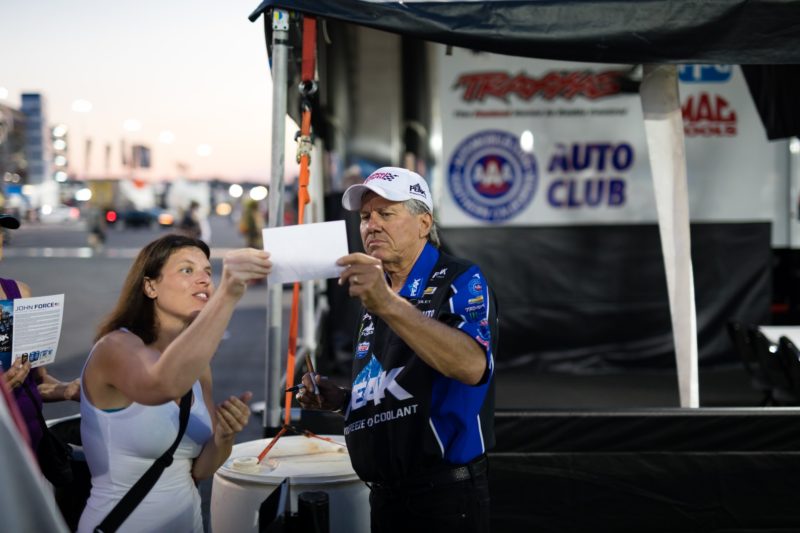
What’s the lesson? What were the successful elements of P.T. Barnum and his circus that are still relevant today, or that we can at least learn from?
There were so many things that tore the circus down, but it was the Greatest Show on Earth for children to go see for well over a century. That’s why I compare it to drag racing. The circus tents go up, the trailers pull into town, they put up the big top – that’s exactly what we do. But the circus is gone. Where did it go? What happened? Things change. Luckily, we don’t have elephants and tigers. We’ve got motors that roar, that’s part of our show. From the lion claws digging into the ground to the tires grabbing the track – it’s so much of the same thing. It might have been financial issues or keeping the animals caged up, but whatever it was – the reality is that they closed down the circus.
The lesson is that circus didn’t close down because it wasn’t a great show. People upset that animals were traveling by railroad – I don’t know what it was – but one of the longest running, most entertaining events in history went out of business. And I get it – our deal is steel and aluminum, titanium and rubber, and horsepower. We’re doing nothing wrong there, so our show can go on. But there’s something very key that we’re missing.
What do you think we’re missing?
When we started racing over 50 years ago, the Connie Kalittas and the Don Garlitses, they were personalities – larger than life. We need that. That’s the difference. The kids today have to get their personalities out there, they have to tell people their story. You do that by living at the ropes, by talking to the people. That’s how you can make a difference.
 I didn’t write the book on this stuff, but I read the book. People like Gene Beaver taught me. People don’t even know who he was. He was my uncle. He raced Funny Cars and dragsters. It was people like him and Tom “The Mongoose” McEwen who were my teachers. So much of the things I created I did because of the likes of Garlits, Muldowney, Prudhomme, McEwen, Kenny Bernstein, Raymond Beadle. These guys were my reason for living, and I’m a little lost without them. I’m struggling a little bit.
I didn’t write the book on this stuff, but I read the book. People like Gene Beaver taught me. People don’t even know who he was. He was my uncle. He raced Funny Cars and dragsters. It was people like him and Tom “The Mongoose” McEwen who were my teachers. So much of the things I created I did because of the likes of Garlits, Muldowney, Prudhomme, McEwen, Kenny Bernstein, Raymond Beadle. These guys were my reason for living, and I’m a little lost without them. I’m struggling a little bit.
I used to be able to call up McEwen, and I would say, “Hey, I have to do this trailer and I have to put Wendy’s Hamburgers on the side of it,” and he’d tell me what to do. One time I painted a map of the United States on the side of the trailer with the locations of races and hamburger stands. It wasn’t just a race trailer. Those were ideas given to me by people like Gene Beaver and McEwen. They started it all. Going down this road, I lived and learned by what they said and the things I saw them do. “Paint a race car and put flames on it,” they’d say. “Give an interview and go crazy, be wild,” they’d tell me. “Put on a show.” It was always a circus; we had to be a circus.
The recent passing of Tom McEwen was an emotional time for the whole sport, but I know you were hit especially hard by his passing. What did “The Mongoose” mean to you?
I got to work the other day and Steve Cole, my marketing guy, was there and I said, “Get in the car, we’re going to get coffee.” We took off. We drove all the way to the beach. He said, “Where are we going?” I said, “I’ve gotta find where McEwen lives.”
I’ve known this guy for 40 years. He’s educated me more than anybody in the sport – ever. I learned from Prudhomme how to win races and I learned from Raymond Beadle how to crash and stand up with your hands over your head and be spectacular. I learned all that. But McEwen taught me the circus side.
We go looking for his house and Steve said, “He passed away, why are we looking for his house?” I said, “I’m going to find his house, I’m going to stand out on the street and stare at his house and his garage and his car until I figure out what’s missing inside of me.” How am I going to make this show better? I owe it to the sport. It made me financially stable in life – wealthy, maybe. What am I going to do to take drag racing to the next level, to try to lead the way, where maybe these kids will look at me and learn from me?
Do you believe we must look back at the past to see where we are heading?
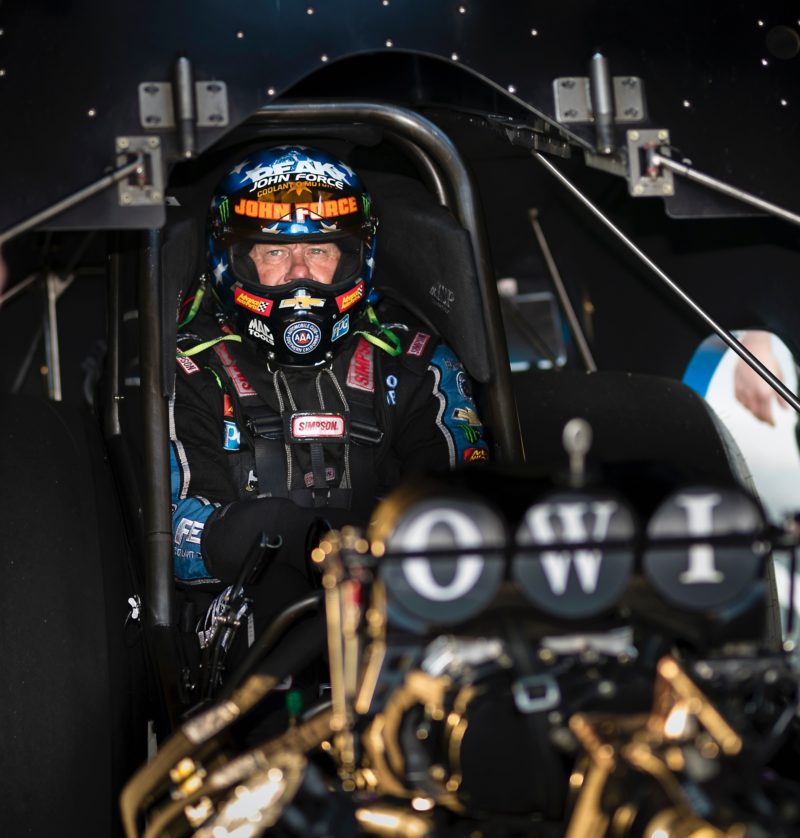 The other day, we got Austin Prock licensed (in Funny Car). The kid is unbelievable. Full of energy. He’s like Eric Medlen. I’m watching him go through his ritual and driving this race car. I’ve known his dad, Jimmy, since he was a little kid. I knew his grandpa, Tom Prock. He drove the “Detroit Tiger” Funny Car. One time we went and had breakfast: Robert Hight, Tom Prock and Al Segrini and me. Just sitting there for an hour, I never spoke and Robert never spoke. Tom Prock and Al Segrini – old-time racers – put on a show that me and Robert walked out in awe of. Just a show telling stories. Talked about the old days, seeing me argue face-to-face with Prudhomme over stupid shit. They just told stories. I said how can you remember that? I didn’t think anyone even saw it. He knows I love Don Prudhomme. Prudhomme will stand up and fight in a minute and so will I. It was just amazing – almost unbelievable the entertainment value that two guys sitting in a coffee shop telling stories could produce. I couldn’t believe just listening to them talk could get me so wired up. We went outside and I told Robert I want to scream, “Hurrah!” It was that motivating. It made me want to go to work, and to remember where we came from, and tell people our story. Those guys were personalities. We need personalities. And you don’t have to go that far back to find them – we’ve had ‘em. Whit Bazemore? He was a personality. Al Hofmann? He was, too.
The other day, we got Austin Prock licensed (in Funny Car). The kid is unbelievable. Full of energy. He’s like Eric Medlen. I’m watching him go through his ritual and driving this race car. I’ve known his dad, Jimmy, since he was a little kid. I knew his grandpa, Tom Prock. He drove the “Detroit Tiger” Funny Car. One time we went and had breakfast: Robert Hight, Tom Prock and Al Segrini and me. Just sitting there for an hour, I never spoke and Robert never spoke. Tom Prock and Al Segrini – old-time racers – put on a show that me and Robert walked out in awe of. Just a show telling stories. Talked about the old days, seeing me argue face-to-face with Prudhomme over stupid shit. They just told stories. I said how can you remember that? I didn’t think anyone even saw it. He knows I love Don Prudhomme. Prudhomme will stand up and fight in a minute and so will I. It was just amazing – almost unbelievable the entertainment value that two guys sitting in a coffee shop telling stories could produce. I couldn’t believe just listening to them talk could get me so wired up. We went outside and I told Robert I want to scream, “Hurrah!” It was that motivating. It made me want to go to work, and to remember where we came from, and tell people our story. Those guys were personalities. We need personalities. And you don’t have to go that far back to find them – we’ve had ‘em. Whit Bazemore? He was a personality. Al Hofmann? He was, too.
You’re absolutely right. A lot of people hated Whit, but they loved to hate him. That’s what we want, right?
A lot of people did, but I never did. I knew we needed him. Everybody said, “The way he talks to you, do you hate him?” No, I love him. I love him because he could motivate me. He’d piss you off so bad. Him and Al Hoffman. Those were personalities. And we’ve got ‘em now. Don’t think we don’t. Cruz Pedregon, he’s an old-school guy – he’s still doing it.
I have to admit that I only recently discovered just how big of a personality Cruz Pedregon is – so full of energy, packed with opinions and a point of view. He’s a live wire. I halfway hate that isn’t something that is front-and-center.
He’s one of the best. No question. He’ll drive the 18-wheeler. That’s what I love about him. He’s on me all the time over stuff. You just wouldn’t believe the crap I’m listening to that these guys get on me about. They’re not annoying to me, though. They’re part of what motivates me. I take that thing that aggravates me about them, and I turn it into a positive. That’s what you’ve got to do. I get rid of the negatives and I turn them into positives, and I move ahead down the road.
You look at this (Steve) Torrence kid in Top Fuel. My daughter won the championship, but he fought her all the way to the end, right up until the last race. In his mind, he believes he won. I don’t even disagree with him. He had a race car that was whipping everybody, then he crashed there in Dallas. But to watch him come out of that car and fight back, he’s got a personality. I love it about him.
There’s so many guys – and gals – who are coming up the ladder. They’re what’s going to save this sport. Maybe there has to be a gap where these personalities have to evolve, but they’re it’s starting to happen. As you get rid of the old-school, the new-school takes over. I’m one of the last ones to hang on. They’ll probably be rid of me soon. The new personalities will come in because TV will find them. Fox Sports will find those personalities and they’ll grow. That’s a positive about our sport. The circus will evolve. I’m old-school and I’m trying to hang on, and I’m trying to help, but maybe it’s stuck in a rut with me.

[Laughs] I don’t know about that, John. I spend a lot of time wondering where we’d be without you, and what we’ll do without you. I do know that you, personally, have been in a few ruts before, but you seem to have come out on the other side. Like when you lost two of your biggest sponsors a few years ago – half your budget – what did it take to move forward?
I think I got a second chance. Two companies looked at me and said, “We’re gonna go with him.” Chevrolet came on board. Of course, Auto Club has been here forever, but then Peak Motor Oil just picked me up. Why? “Well, who knows the business better than you, John Force? You’ve been in the oil business for 30-40 years. You know the contacts and you can do nothing but help us.” It made sense.
Something about my longevity in the sport is what’s kept me going. It’s what I know. Sometimes I just feel like God is talking to me, telling me, “You have enough money to retire and go learn how to fish or golf.” People love that stuff, but I hate it. I love race cars. But what’s amazing is that I was given an opportunity, and it was an opportunity to go out there and keep racing – they ain’t just handing me this money to stand around. There’s a reason, and it’s to race. And people might think I’m out here trying to kill myself with all these crashes and stuff, but I’m not.
You’ve got to admit, though – there’s a positive with those negatives. Those explosions I had? You could read the sponsor’s sign 300 feet in the air. I got ‘em on the front of magazines, on television, in newspapers, all over social media. They’re like, “Oh my God, you didn’t win the race.” No, I didn’t, but I got more exposure than the guy who did. And I don’t want to get it that way, but I’ll take it. A lot of people think I have a death wish, but I don’t.
I didn’t think we’d be able to avoid talking about some of the drama that has unfolded this season for you – these massive explosions and such.
Race cars have a personality of their own. You can’t even blame the crew chief or the team, or anybody. The stuff that affected our team started at the Phoenix test, followed us to Pomona and put me in the hospital. Then I come back to the track and my daughter Brittany rolls over in the Top Fuel car. Then we go to Phoenix and it happens again (with the Funny Car). Then we go on to Gainesville and it happens again. Then it’s like, “Wait a minute. I’ve been doing this for a hundred years. I’ve had problems. But this is different.” Everything just went wrong. I said, “Let’s slow down and evaluate this.” I had plenty of time. I laid in the hospital bed for days thinking about it, thinking maybe somebody else is trying to tell me something. In the end, I understand what it’s all about. I’ve been through it too many times. It wasn’t anybody’s fault. It was something we got caught in the middle of.
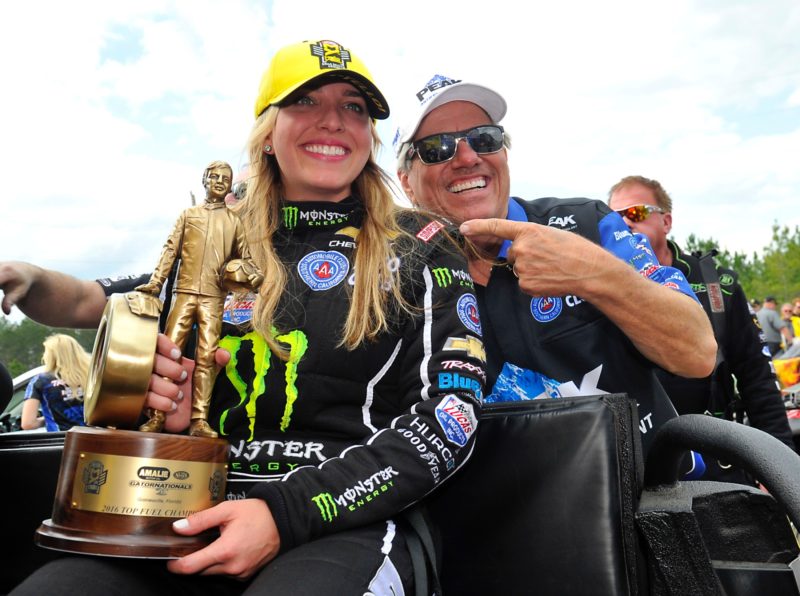
I know those incidents earlier this season took a physical, emotional and financial toll on you, and you’re telling me that you thought it might have been a sign. What made you think it wasn’t? Or is it simply that you’re not willing to go out like that?
It isn’t, at least to me, just about winning. It’s about staying in the game. I ain’t doing it for the money – I don’t need the money. I’m spending my own money at this point, financing my cars. We had over a million dollars in explosions and crashes this year. Counting my daughter’s car, we lost maybe four cars. That’s over a million dollars – that’s a fact. Where’s that come from? That don’t come from sponsors. That comes right out of my savings. They don’t pay me to crash, they pay me to win.
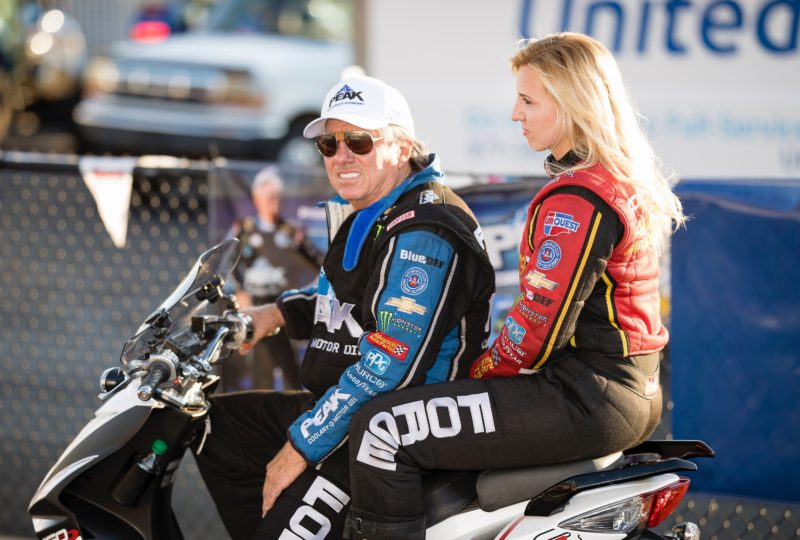 So, I have to evaluate all that and hear the things I’m hearing behind my back, but it’s all part of the game. They’ll learn because they’ll go through it. They’ll get snake-bit and they’ll wonder why everything that could go wrong went wrong. It’s only because of my age that they question me, the other drivers, so to speak.
So, I have to evaluate all that and hear the things I’m hearing behind my back, but it’s all part of the game. They’ll learn because they’ll go through it. They’ll get snake-bit and they’ll wonder why everything that could go wrong went wrong. It’s only because of my age that they question me, the other drivers, so to speak.
I just try to make a positive out of it, and that I was given the opportunity to race through Peak, Auto Club and Chevrolet. Advance Auto Parts and Monster came on with my daughters. I’m not the greatest marketeer in the world, but I stay after it seven days a week. We’re workaholics. This racing does it to you. It makes it to where it’s all you think about, even when your shoulder’s in pain and you’re beat up. You get back in that race car. I feel safe in it and I’m protected in it. Now, I’ve got to learn from my mistakes. My job is not only to put on a show and my job is to win, and that’s what I’m trying to do. My job is also to keep me safe, and keep the guy in the other lane safe, while still fighting to win. That’s why I drive on the edge. That’s why people think, “Does he have a death wish?” No, I don’t.
But I don’t want to die in a rocking chair on my front porch either. I’ve said that. I hate that idea. We were sitting out there on Lake Tahoe the other day, sitting around talking and we only had one chair. Someone said we ought to get a rocking chair so we have another chair. The first thing I said was, “Are you talking about me? Are you getting a chair for me? Don’t get me no rocking chair. I don’t want to sit here in a rocking chair.” My rocking chair is in the seat of my race car and that’s where I’m sitting. That’s why I’m happy when we leave for the race track. When we’re leaving vacation to go back to the races. My wife see it and my kids see it. They saw it 25-30 years ago, too, but now that they’ve grown up and they’re racing – they get it.
Rewinding here briefly and getting back to the topic of personalities in drag racing, I’m curious – who are some of the personalities on your radar in 2018?
The personalities in drag racing are starting to evolve. I’m starting to hear them and see them, and it excites me. To hear the ones out there who get excited and give their opinions. We want their opinions. That’s what’s going to make this sport greater.
I have a lot of faith in drag racers. It takes a special personality to be a drag racer, man or woman. You’ve got to be a special breed, and we have that with the Steve Torrences, the Ron Cappses, the Tim Wilkersons of the world. The personalities are coming, and now they’re coming out of the woodwork. The guy who won the last race in Top Fuel (Blake Alexander), I still can’t even remember his name. I didn’t even know he was in the race and he wins it. He’s in the shutdown area dancing. The personalities are coming.
The new personalities are starting to evolve, and it’s not just in Funny Car. We have a ton of ’em, but they’re coming in Top Fuel, too. The cars are starting to have personalities, too. It used to be the “Snake” and the “Mongoose”. Now, I look out and see a big, giant alligator painted on the side of Terry McMillen’s car. People say, “I know that guy! It’s the alligator car! It’s the guy with the sunglasses and the mustache!” Watching Ron Capps go through his routine before he climbs in that race car. And Matt Hagan, a mountain of muscles. It’s amazing what we’re starting to see. So much of this is evolving. We’re not going to fail like P.T. Barnum – this movie ends different. Our sport is going to be OK, and it’s these personalities that will carry us forward.
Beyond the personalities, what is it going to take to take NHRA drag racing to the next level?
Being willing to make changes. That’s why our sport is going to be OK – because NHRA is making changes. (Tom) Compton did things to make the sport better. So did Wally (Parks), so did Dallas (Gardner), and now Peter Clifford and he just passed the baton to Cromwell. And I will tell you that Cromwell has had more meetings with racers to learn about what they think than maybe anyone ever before, and I really like that. But he’s grown up in the field, on the racetrack. He knows where we come from. He comes from stadium racing, motorcycles and off-road. He gets it, and he knows the show.
That’s been something I’ve heard a lot about Glen Cromwell – just a unique willingness to listen. That’s long since been the characteristic of a good leader.
A lot of the people that have ran our sport were bankers. They were money people, and they did a great job – you need those people. But I think we’re going to see a lot of change moving forward.
You put on a stadium show. You have so many square feet to put the show on. You have to entertain them from the minute they walk in the door until they leave. That is the key, and that’s what Cromwell brings to the party. I watched him set up a winner’s circle. “You’re the top guy! What are you doing out here messing with aluminum scaffolding and banners?” He understands the show, the timing, the lights, the explosions. He’s always learning and getting a real education on drag racing. He thought he knew it. In another two years, he’ll really know it.
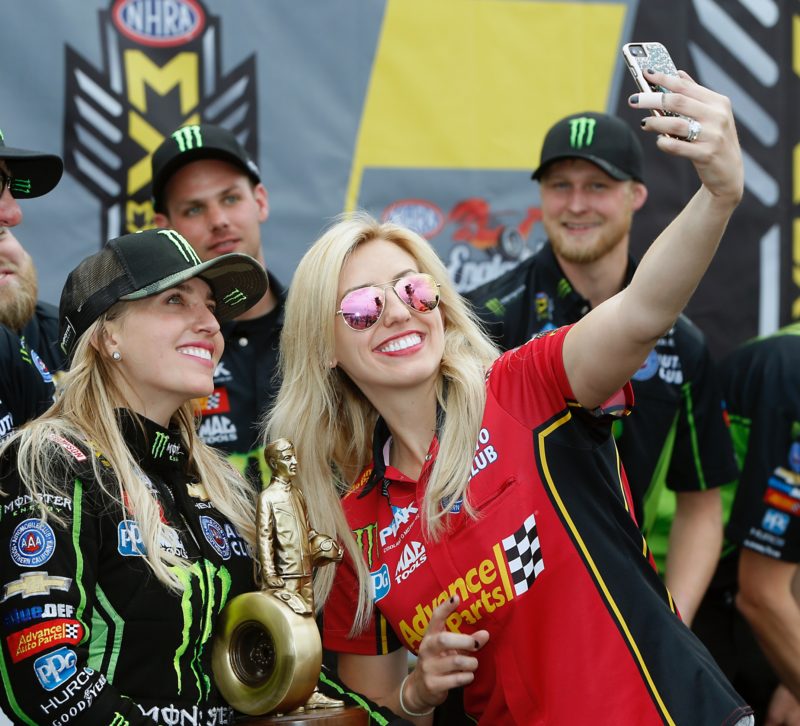
Photo by Randy Anderson/NHRA
We’ve talked a lot about the circus this morning, and the way I see it – you’ve always been the center beam, holding up the big tent that is professional drag racing. You do all the interviews, you yell and you scream, you go out on the track and you’re spectacular – in victory and defeat, and everything in between. I know it’s been the love of your life, but I cannot imagine this has not weighed heavy on your shoulders. Do you feel that? Have you not stepped away from the driver’s seat because of a responsibility you feel to see this deal through?
I’m not going to be around forever. We know that. But I don’t lead this charge. I lead it as a race team owner and a driver, but it’s not just my circus. I think my drivers all do a good job, and they’re all different personalities, but I believe Robert, Brittany and Courtney, as well as Ashley, they knew the ritual because they watched me for so many years. The other personalities are forming. I’m watching them grow and I’m loving it. I’m excited because one of these days when they do get me strapped to that rocking chair, I’m going to be able to turn on that TV and I’m going to be able to watch drag racing.
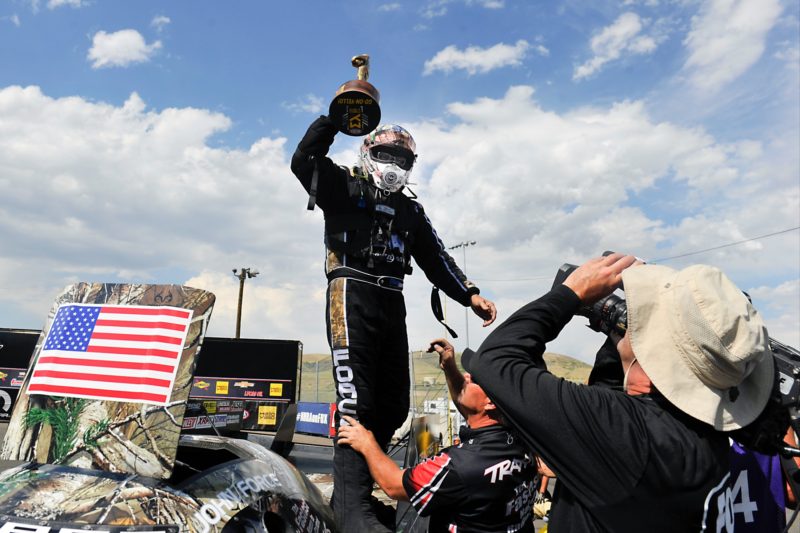 And if nothing else, I want my granddaughter and grandsons – if they decide to race – to have the best opportunities. We were down at Barona Drag Strip in California with the grandkids racing their Jr. Dragsters. What was amazing was when Danny Hood opened Jacob’s visor so Jacob could hear him – he was trying to explain the Christmas tree – little Noah, who’s a year younger than Jacob, runs around in front of the car. And I was so upset. I was thinking, he can’t be up on the starting line like that. But he looked at me and he said, “Grandpa, I’m the crew chief. I have to be up there.” The little guy ran in front of the car – I swear to God, Ashley has pictures of it – and hit the hood of the car and put his thumb up to Jacob in the car. I said, “Noah, you can’t run out there. He’s listening to his dad.” Noah goes, “I have to be with him, Grandpa. I’m his crew chief.” This kid can hardly talk and he said this.
And if nothing else, I want my granddaughter and grandsons – if they decide to race – to have the best opportunities. We were down at Barona Drag Strip in California with the grandkids racing their Jr. Dragsters. What was amazing was when Danny Hood opened Jacob’s visor so Jacob could hear him – he was trying to explain the Christmas tree – little Noah, who’s a year younger than Jacob, runs around in front of the car. And I was so upset. I was thinking, he can’t be up on the starting line like that. But he looked at me and he said, “Grandpa, I’m the crew chief. I have to be up there.” The little guy ran in front of the car – I swear to God, Ashley has pictures of it – and hit the hood of the car and put his thumb up to Jacob in the car. I said, “Noah, you can’t run out there. He’s listening to his dad.” Noah goes, “I have to be with him, Grandpa. I’m his crew chief.” This kid can hardly talk and he said this.
I sat in the stands all day that day. I wanted the kids to have their own experience, and I knew they wanted me in the stands because, truthfully, I’m a pain in the butt. But I watched that day, and I was thankful. I was thankful to have this sport, and for what it’s given me and continues to give me.
When I stand there, I can take all the beatings, all the people getting mad for all the stuff I do wrong, and I love ’em for it. I want them to know that. I never told McEwen that I loved him, and I wished I had before he passed. So, I’ll tell ‘em all. I don’t care if it’s Schumacher, Capps, Tommy Johnson, Jim Head, Chad Head or the list goes on and on, because they’re all I’ve got. I don’t have no friends. The guy down at the doughnut shop and the lady at the laundromat are the only friends I’ve got outside of this place. Those are the only other places I go, and then I go to the race track. Those guys made me what I am today, and I owe them a big thanks.
They make me better because every morning when I get up and I roll over on my shoulder – and, boy, do I wake up, because it’s painful – but I go, “Why do I need to get up, and go do this again?” Because I owe it to them. They made me what I am today and I owe them. The old ones: the Raymond Beadles, the Mongooses, Prudhomme, Garlits, Shirley. And I owe the new ones: Cruz, Head, Tommy Johnson, Capps, Hagan. I love ’em. I love to watch ’em go by in their fire suits and put on their helmets and do their thing – “I’m gonna go break your back, Force!” I can almost hear them say it. I love it. And they have almost broke my back. Or, well, I almost have.
Photographs by Rick Belden and NHRA/National Dragster

